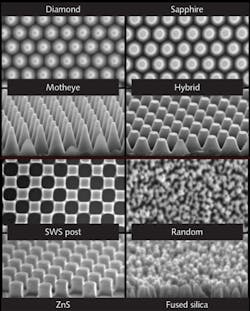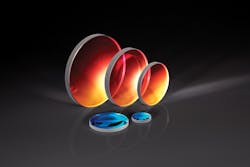Laser Optics: Antireflection nanotextures for laser optics go commercial
For most laser-system optical designs, reflections from transmissive optical components are detrimental to system performance. These reflections can be avoided by modifying the surface of the transmissive element. Thin-film optical coatings are a well-established technology for providing such antireflective properties at laser wavelengths. These coatings consist of thin layers of alternating material deposited on the lens surface. The material choice and exact thicknesses of each layer determine the antireflection (AR) properties of the resulting thin film coating.
Despite their popularity, practical limitations of the thin-film manufacturing equipment and materials used often force the optical designer to optimize the component for only a single or dual laser wavelength, allowing fairly high reflectivity at other wavelengths near the design laser.
Random antireflective (RAR) nanostructures are unencumbered by such practical limitations and may be designed to provide ultralow reflectance over a very broad wavelength range. This technique can be used by laser-system designers and integrators to simplify their designs, replacing costly custom coated windows and lenses with off-the-shelf designs to cover a wide range of laser wavelengths and applications.
Since Wilson and Hutley detailed the principles and potential advantages of "motheye" antireflection (AR) surface textures back in 1982, the photonics community has awaited the point in which such AR-textured optics would become commercially available.1 While several research organizations have detailed the performance advantages of such motheye-type AR nanotextures, the ability to fabricate them in a repeatable, production-worthy fashion that allows for low-cost/high-volume production has proven to be challenging.
TelAztec (Burlington, MA) has been in development and test of a broad range of AR nanotexture designs ranging from periodic-array textures—including its motheye, hybrid, and subwavelength structure designs—to RAR textures that comprise a randomly distributed array of nanoscale features, fabricated through a process that the company has patented (see Fig. 1).
While the periodic textures require a lithography step followed by an etch step, the RAR texture is fabricated through a single one-step dry-plasma-etch cycle, eliminating the costs and time associated with lithography processing. The RAR texturing and manufacturing process is now at the point where it results in fully qualified and lifetime-tested laser windows and lenses specifically targeting high-power continuous-wave (CW) and pulsed industrial, medical, and scientific laser platforms that require high optical performance combined with high laser-damage threshold levels.
RAR nanotexture function and performance
Random AR nanotextures are similar to motheye textures—subwavelength surface-relief textures that are fabricated directly in an optic and that produce a gradual transition in the material density (refractive index) encountered by light passing through. The density, spacing, and height of the RAR textures determine how efficient the texture is at suppressing reflected light.
Unlike thin-film interference coatings, the gradient-index effect of the RAR texture design allows for ultrabroadband operational bandwidths and extremely low losses while performing to acceptance angles of 60° and beyond. For example, currently available broadband RAR-textured laser windows or lenses (made of, for example, Corning 7980 Grade 0A high-purity fused silica) have been designed to exhibit a per-surface reflection loss of either <0.1% over the spectral range of 532 to 1100 nm, or the same level of performance over the 266 to 532 nm spectral range with minimal loss at 45° angle of incidence.
With the rise in laser power levels in a variety of application areas including cutting, welding, medical laser treatments, sensors, and military-force protection, the need for high laser-damage-threshold, long-lifetime AR surfaces has become even more critical to optical designers.
One of the most important approaches for increasing laser damage levels and overall lifetime for laser optics is to eliminate the inherent surface absorption seen with dielectric thin-film antireflection coatings (TFARCs). While TFARCs can be designed to minimize absorption, surface-absorption measurements of thin-film coated optics reveal surfaces littered with absorption spikes. These spikes result in absorption hot spots that inevitably lead to failure.
In contrast, since no dissimilar materials are used with the RAR nanotexture process, absorption testing has confirmed that no absorption is associated with the RAR surface textures. This reduces heating of the optical surface—as a result, RAR textured optics can be operated at lower temperatures than TFARC samples, eliminating thermal lensing issues and resulting in long-term beam stability for RAR-treated optics. With these fundamental advantages, certified pulsed and CW laser-damage testing has consistently shown RAR textured optics surviving laser damage levels significantly higher than catalog high-power laser-window thin-film AR coating specifications (see Fig. 2).2,3RAR availability
While RAR-textured optics offer many advantages over thin-film coatings, until recently they have not been available as stock components, limiting their potential to those groups capable of manufacturing the RAR textures themselves. With the technology now available off the shelf, the flexibility and strengths of RAR technology can be fully exploited from small-scale R&D through volume production.
RAR-textured optics have the significant advantage of providing low reflectivity over a wide wavelength range. This allows the same RAR texturing to function as an antireflection coating for multiple laser wavelengths simultaneously. For example, flow cytometers typically integrate multiple lasers with useful wavelength ranges spanning the near-UV through the near-IR. Thin-film AR coatings designed for the full range of flow-cytometry wavelengths would need to feature significant compromises, either in maximum reflection or angle of incidence, to achieve acceptable performance over that broad range. More likely, a unique coating design would be necessary for each wavelength.
Conversely, a single RAR textured element can be used for the complete wavelength range. Moreover, the broadband nature of the RAR coating almost ensures that a stock element is available at the desired wavelength. This enables rapid prototyping and allows for easy wavelength tuning during the design phase of the laser optical system. In contrast to traditional thin-film coatings, no additional design resources are required for each change of wavelength.
The benefits of RAR textured optics extend into the production phase of optical systems as well. As a single RAR-texturing process can cover multiple wavelengths, there is no need to maintain separate manufacturing processes for each wavelength. In addition, RAR manufacturing cycle "run" times are a fraction of those for thin-film coating deposition runs—which for more complicated coating designs can be more than several hours. This enables lower minimum order quantities for each optic separately, reducing lead time for the optics all while reducing inventory and time-to-market.
REFERENCES
1. S. J. Wilson and M. C. Hutley, OpticaActa, 29 (1982).
2. D. S. Hobbs et al., "Contamination resistant antireflection nanotextures in fused silica for laser optics," Proc. SPIE, 8885, 88850J (2013).
3. D. S. Hobbs et al., "Continued advancement of laser damage resistant optically functional microstructures," Proc. SPIE, 8530, 85300O (2012).
About the Author
Jim Nole
Director of Marketing, TelAztec
Jim Nole is director of marketing at TelAztec (Burlington, MA).
Gregg Fales
Senior Product Line Manager, Edmund Optics
Gregg Fales is senior product line manager, both at Edmund Optics (Barrington, NJ).
Stefaan Vandendriessche
Laser Optics Product Line Manager, Edmund Optics
Stefaan Vandendriessche is laser optics product line manager at Edmund Optics (Barrington, NJ).

